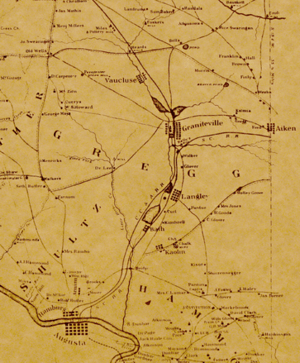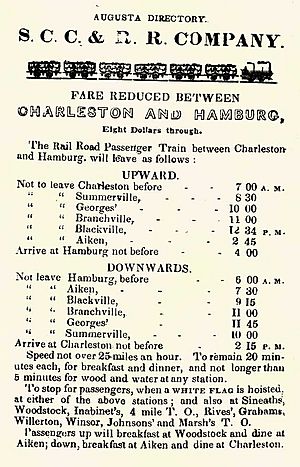Horse Creek Valley facts for kids
Horse Creek Valley is a special area in Aiken County, South Carolina. It follows along Horse Creek, a small river that flows into the Savannah River. Before 1872, this area was part of Edgefield County. Sometimes, people call it "Midland Valley." Horse Creek starts near Vaucluse, South Carolina and joins the Savannah River a little ways past Augusta, Georgia.
Many towns are located along Horse Creek, like Graniteville, Warrenville, Gloverville, Langley, Burnettown, Bath, and Clearwater. Even though Horse Creek is not very big, its strong current was perfect for early factories. This led to some of the first industries in the South, like a textile mill (a factory that makes cloth) in Vaucluse in 1830. Later, William Gregg built his famous Graniteville Mill in 1845. Making cloth was a very important business here until the Graniteville Train Derailment in 2005, which led to the Graniteville Mill closing in 2006.
Contents
History of Horse Creek Valley
Early Days (1600s and 1700s)
In 1674, Henry Woodward explored this area. He wrote about the Westo people living there. The Westoes were known for capturing people from other tribes. They would then trade these captured people with settlers in Virginia.
Later, in 1690, a trade war led to the Westoes leaving the area. For a short time, the Shawnee people lived there. In 1723, the South Carolina government invited the Chickasaw people to move to the valley. The Chickasaw, who lived in northern Mississippi, needed guns from South Carolina. So, they agreed to send a group of their people.
By 1737, the Chickasaw were given a large piece of land (about 21,774 acres) along Horse Creek. They worked with the English to protect this land, especially during the Anglo-Cherokee War in 1760. The Chickasaw returned to their homeland just before the American Revolutionary War.
Growth in the 1800s
The farming of cotton grew very quickly, which helped towns like Augusta in Georgia and Hamburg in South Carolina grow. Farmers would bring their cotton bales by wagon to these towns. They would sell the cotton to warehouses or load it onto boats. The boats would then take the cotton to Savannah or Charleston, and from there, it would go to cloth factories in the northeastern U.S. and Europe. After selling their cotton, farmers would buy goods to take back home.
To make it easier to move goods, the South Carolina Rail Road was finished in 1833. This railroad connected Hamburg to Charleston. It was 136 miles long, making it the longest railroad in the world at that time! It ran on a regular schedule using only steam trains.
Horse Creek was very important because its strong water flow could power factories. An 1885 study said that Horse Creek "has a rapid fall, offering excellent advantages for power." This meant it was easy to get a lot of power from the creek without spending too much money.
The first cloth factory in Horse Creek Valley opened in Vaucluse in 1830. But it didn't do very well. William Gregg, who believed in building more factories in the South, learned from these mistakes. He built a very successful cloth factory in Graniteville in 1845. Even though Gregg's factory was a big success, many people in the South still preferred farming with forced labor. So, other factories like his weren't built for many years.
Other businesses also used Horse Creek's water power. There was a paper mill in Bath and pottery factories near Vaucluse. In 1860, one pottery factory made 40,000 gallons of stoneware (a type of pottery) each year. The famous potter Dave worked at one of these factories as late as 1863.
After the American Civil War and the time of Reconstruction, the cloth-making industry grew a lot. By 1900, many factories were operating in the valley, including the Graniteville, Seminole, and Vaucluse mills. These factories provided many jobs for people living in the valley.
The 1900s and Beyond
During the 1900s, a popular winter vacation spot for rich people grew at the top of the valley. This area became known as the Aiken Winter Colony. People enjoyed activities like polo (a sport played on horseback) at the Whitney Polo Field, started in 1882, and golf at the Palmetto Golf Course, which began in 1892. The love for horses is still very strong in Aiken today.
In 1903, the Hampton Terrace Hotel opened in North Augusta, South Carolina, near the lower end of the valley. A railway connected it to Aiken. Famous and powerful people like John D. Rockefeller, Henry Ford, and Bing Crosby stayed there for vacations.
The cloth-making businesses faced tough times because of the boll weevil (an insect that destroyed cotton crops) in the 1920s and the Great Depression in the 1930s. After World War II, the factories continued to struggle.
In 2005, the last remaining mill was affected by the Graniteville Train Derailment. A train crash caused a chlorine gas leak early in the morning, which sadly killed nine people in the area. The owners of the Graniteville Mill said that the chemical damage from the spill made it too expensive to fix the factory. So, the mill closed in 2006.
After a big cleanup, Langley Pond, at the lower end of the valley, became a fun place for recreation. This pond, which used to be part of a mill, now has an Olympic-sized course for rowing. It was even used for practice before the 1996 Summer Olympic Games. The lake still hosts rowing teams who come for warm-weather practice in the winter. Rowing races there attract over 1,000 rowers.
In 2011, two movies were made about the valley. One was called Graniteville: Past, Present, Future, which talked about William Gregg, the train derailment, and ideas for the future. The other movie, Horse Creek Valley... A Tale Worth the Telling, covered 13,000 years of the area's history up to the present day.



